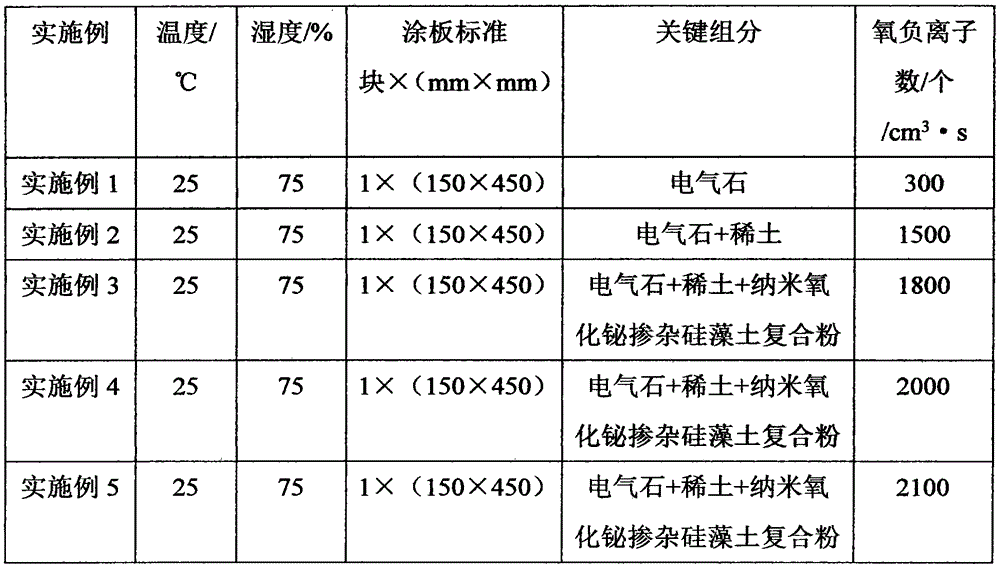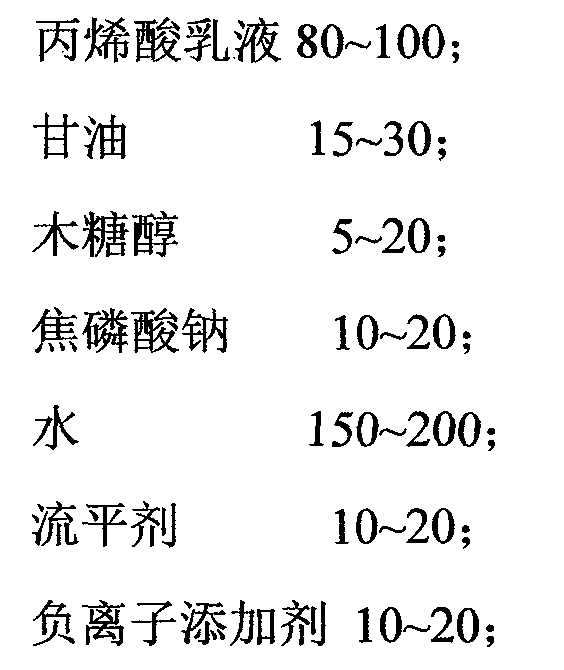Waterborne paint capable of releasing negative ions and preparation method thereof
A water-based paint and negative ion technology, applied in the paint field, can solve the problems of large dosage and high production cost, achieve the effects of reducing dosage, reducing production cost, and improving antibacterial and air purification effects
- Summary
- Abstract
- Description
- Claims
- Application Information
AI Technical Summary
Problems solved by technology
Method used
Image
Examples
Embodiment 1
[0024] The water-based paint capable of releasing negative ions in the present embodiment comprises the raw material composition of following mass parts: 80 parts of acrylic acid emulsions, 15 parts of glycerin, 5 parts of xylitol, 10 parts of sodium pyrophosphate, 150 parts of water, 10 parts of leveling agent parts, 10 parts of anion additives; wherein, only tourmaline is contained in the anion additives.
[0025] The preparation process of the water-based paint that can release negative ions is as follows: pour water into the container, pour xylitol and stir until it is completely dissolved, then pour glycerin and stir, then pour sodium pyrophosphate and stir until it is completely dissolved, the speed is 500rpm, and the obtained The solution is ready for use. Pour the corresponding acrylic emulsion into the container and mix well with the above standby solution. Finally, add negative ion additives, stir at high speed for 30 minutes, rotate at 2000 rpm, then adjust the rot...
Embodiment 2
[0027] The water-based paint capable of releasing negative ions in the present embodiment comprises the raw material composition of following mass parts: 80 parts of acrylic acid emulsions, 15 parts of glycerin, 10 parts of xylitol, 15 parts of sodium pyrophosphate, 150 parts of water, 10 parts of leveling agent Parts, 10 parts of negative ion additive; Wherein, negative ion additive is made up of the raw material of following mass fraction: 20 parts of tourmaline, 3 parts of rare earth, 2 parts of surfactant.
[0028] The preparation process of the water-based paint that can release negative ions is as follows: pour water into the container, pour xylitol and stir until it is completely dissolved, then pour glycerin and stir, then pour sodium pyrophosphate and stir until it is completely dissolved, the speed is 500rpm, and the obtained The solution is ready for use. Pour the corresponding acrylic emulsion into the container and mix well with the above standby solution. Finall...
Embodiment 3
[0030] The water-based paint capable of releasing negative ions in the present embodiment comprises the following raw materials in parts by mass: 100 parts of acrylic acid emulsion, 20 parts of glycerin, 15 parts of xylitol, 15 parts of sodium pyrophosphate, 180 parts of water, and 15 parts of leveling agent parts, 15 parts of anion additives; wherein, the anion additives are made up of the following raw materials in mass parts: 25 parts of tourmaline, 3 parts of rare earth, 2 parts of surfactant, 70 parts of nano bismuth oxide doped diatomite composite powder.
[0031] The preparation process of the water-based paint that can release negative ions is as follows: pour water into the container, pour xylitol and stir until it is completely dissolved, then pour glycerin and stir, then pour sodium pyrophosphate and stir until it is completely dissolved, the speed is 500rpm, and the obtained The solution is ready for use. Pour the corresponding acrylic emulsion into the container a...
PUM
 Login to View More
Login to View More Abstract
Description
Claims
Application Information
 Login to View More
Login to View More - R&D
- Intellectual Property
- Life Sciences
- Materials
- Tech Scout
- Unparalleled Data Quality
- Higher Quality Content
- 60% Fewer Hallucinations
Browse by: Latest US Patents, China's latest patents, Technical Efficacy Thesaurus, Application Domain, Technology Topic, Popular Technical Reports.
© 2025 PatSnap. All rights reserved.Legal|Privacy policy|Modern Slavery Act Transparency Statement|Sitemap|About US| Contact US: help@patsnap.com


